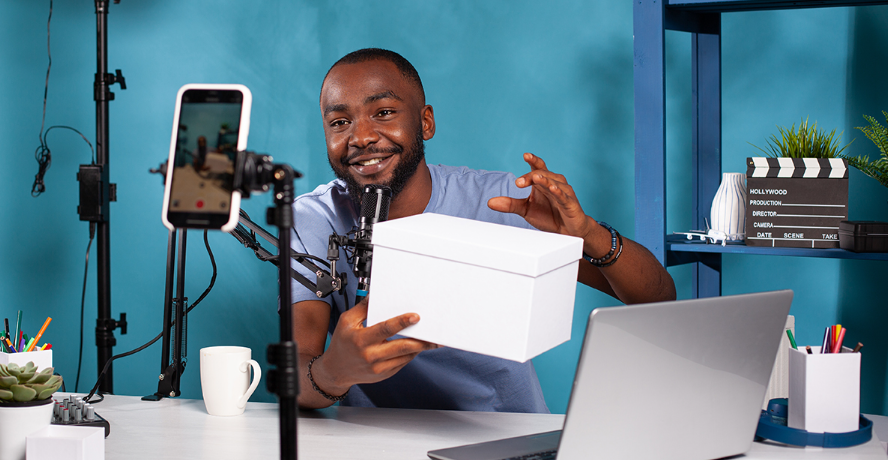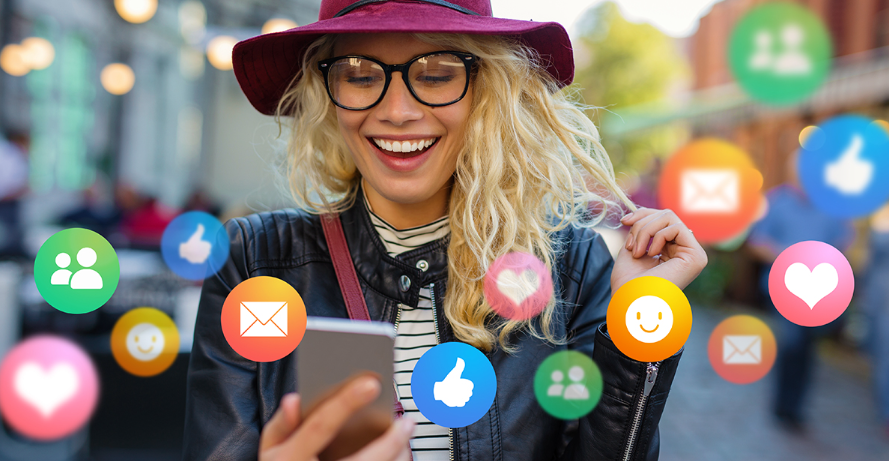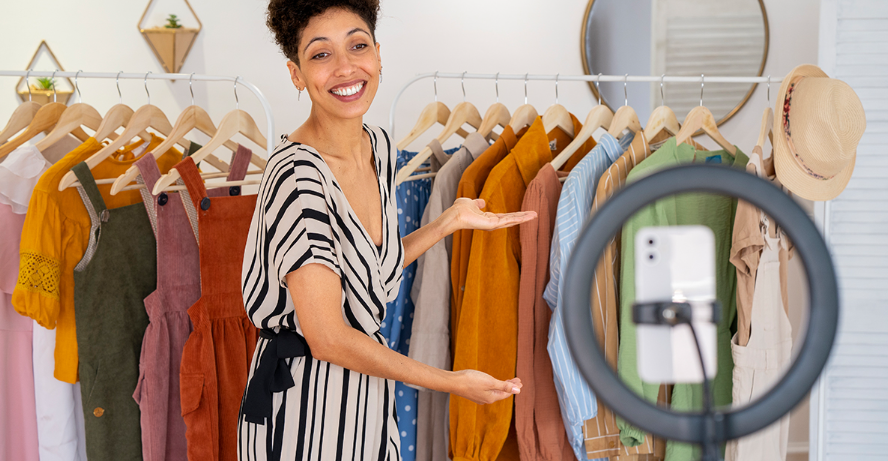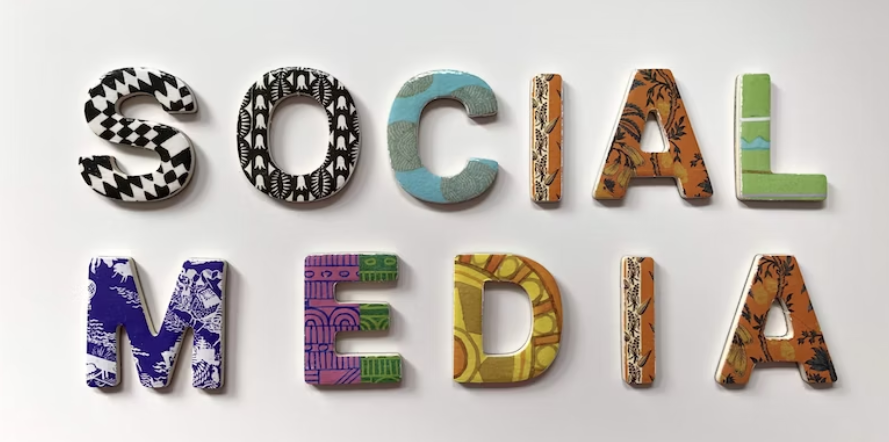Influencer marketing has rapidly transformed into a powerful strategy for businesses to forge connections with their target audiences in recent years. The undeniable fact that 92 percent of marketers recognize influencer marketing’s efficacy speaks volumes about its impact.
Yet, what truly distinguishes influencers from the rest? It’s their unparalleled ability to forge authentic connections with their audience. Astonishingly, influencers have earned a higher level of trust compared to even the most renowned celebrities. According to research, an impressive 50 percent of Millennials place their faith in influencers for product recommendations, as opposed to 38 percent for their beloved celebrities.
- Times have changed. Celebrities no longer reign supreme with their endorsements. Today, it’s the influencers who command the world of influence.
Let’s dive into the evolving domain of influencer marketing, probing how the fusion of digital impact and physical products is steering the course of the future. Get ready to explore the dynamic landscape where authenticity converges with marketing skills.
The power of digital influence

The impact of digital influence extends far and wide, reshaping how brands connect with audiences. Trust and authenticity flourish through strategic partnerships, while social media platforms become launchpads for brand elevation.
Exploring the reach and impact of digital influencers

In the vast expanse of digital landscapes, the influence of digital influencers goes beyond screens and pixels, extending into the purchasing choices people make. In this exploration, we’ll discuss the profound reach and impact these modern tastemakers wield, shaping consumer behaviors and redefining brand-customer interactions.
Digital influencers possess the ability to transcend geographical boundaries, reaching audiences across the world. They often specialize in specific niches, catering to audiences with shared interests. This specialization allows brands to target niche markets more effectively. From YouTube and Instagram to TikTok and blogs, influencers easily navigate various platforms, maximizing their exposure to different audiences.
Influencer marketing evolves, shaping a landscape where connections are forged, trust is built, and consumers are empowered in unprecedented ways. It’s clear that influencer impact has transcended mere promotional posts. Their recommendations carry weight, rooted in trust cultivated over time.
Trust and authenticity
Digital influencers cultivate trust among their followers through genuine and relatable content, making their recommendations more persuasive than traditional advertising.
Purchase decisions
The influence of digital influencers directly impacts consumers’ purchasing decisions. A positive endorsement can alter buying choices significantly.
Brand perception
Collaborations between influencers and brands shape how consumers perceive the brand, aligning it with the influencer’s persona and values.
Consumer insights
By analyzing influencer content, brands can gain valuable insights into consumer preferences, helping refine product offerings.
Innovation catalyst
Influencers introduce audiences to new products and trends, catalyzing innovation in various industries.
As influencer marketing converges with strategies that businesses like print-on-demand companies employ, the blend of digital sway and real-world impact becomes evident. Brands recognize the symbiotic relationship between influencers and marketing strategies, leveraging their reach and impact to amplify their presence in both virtual and physical realms. This is particularly true in the realm of e-commerce development, where the right strategies can make a significant difference.
Leveraging social media platforms for brand promotion

In the vast domain of digital influence, social media platforms stand as the modern arena where brands can wield their promotional prowess. These platforms have become more than just spaces for connection; they’ve evolved into vibrant spaces for businesses to amplify their presence and create engagement with their audiences.
Ways to leverage social media for brand promotion
- Engaging content creation: Crafting compelling and relatable content is the cornerstone of social media success. Content must truly connect with your intended audience, which holds immense importance through captivating visuals, informative videos, or thought-provoking captions.
- Influencer collaborations: Partnering with digital influencers whose followers align with your target demographic can provide authentic and far-reaching endorsements.
- Hashtag campaigns: Creating and promoting unique hashtags can make your brand’s content discoverable and encourage user-generated content that bolsters brand visibility.
- Live streaming: Platforms like Instagram Live and Facebook Live enable real-time interactions with audiences, offering an opportunity to showcase products, conduct Q&A sessions, and build a personal connection.
- Interactive features: Polls, quizzes, and interactive stories prompt engagement and elicit responses from your audience, fostering a sense of involvement.
Social media platforms for brand promotion:
- Instagram: Renowned for its visual allure, Instagram serves as an ideal platform to showcase products and narrate your brand’s journey through captivating images and videos.
- Facebook: With its diverse array of users, Facebook offers a realm to share content, interact with followers, and effectively employ targeted ads.
- Twitter: In its succinct format, Twitter is perfect for quick updates, news dissemination, and real-time conversations that engage your audience.
- TikTok: Embracing short-form videos, TikTok provides an outlet for crafting creative, immersive, and often viral content experiences.
- LinkedIn: Primarily for professional networking, LinkedIn is valuable for B2B businesses and establishing thought leadership.
Bringing together social media platforms and brand promotion is a strong alliance. It’s about more than just pushing products; crafting a genuine online presence that resonates with your audience.
Furthermore, social media management tools can help to craft out a consistent message or a story over time and schedule several weeks of posts ahead. By embracing these platforms and employing strategic approaches, businesses can harness the power of digital influence to create lasting brand connections that transcend the virtual world.
Building trust and authenticity through influencer partnerships

Trust and authenticity are the gold standards that propel brands forward. If you do it right, customers will be chasing you instead of you chasing them.
That’s why marketing is more crucial than the product, because you can always outsource the development and delivery of your products in the same way that digital marketing agencies outsource their packages to an SEO reseller.
Brands can achieve this through strategic influencer partnerships. These partnerships transcend the transactional, creating genuine connections that resonate with audiences, making a sense of reliability and credibility that traditional advertising struggles to achieve.
The path to trust and authenticity
The key to this path lies in the credibility of influencers’ recommendations. Their authentic endorsements hold more weight than traditional advertising, as they stem from a place of personal belief.
Moreover, the relatability factor plays a significant role. Influencers are skilled at crafting content that mirrors real-life experiences. This relatability creates an instant connection, as audiences can see themselves in the stories and situations shared by influencers. It’s like receiving advice from a friend who has genuinely experienced a product or service.
Long-term relationships are another key factor in building trust and authenticity. Regular collaborations between brands and influencers cultivate a connection between them. Audiences notice these partnerships are rooted in mutual respect and a shared understanding of the product’s value.
The power of influencer partnerships
In the grand scheme of brand promotion, influencer partnerships hold remarkable power as a sales strategy. When influencers endorse a product or service, they lend a personal touch that resonates with their followers. This makes the brand more approachable and relatable, bridging the gap between consumers and corporations.
Influencer partnerships also use storytelling so brands can spin narratives that evoke emotions. These stories engage audiences on an emotional level, developing connections that go beyond simple transactions. A crucial part of this storytelling is their personal branding on social media, which allows influencers to maintain a consistent and authentic image across platforms.
Influencer interactions are transparent and candid. Often, influencers engage directly with their followers, responding to queries, sharing experiences, and providing authentic insights. This transparency adds layers of authenticity to the brand’s messages, reinforcing the sense that the recommendations come from real people rather than scripted advertisements.
Expanding into physical products

In this changing landscape, it’s not just about products; it’s about seamlessly connecting digital networks and physical products. This journey opens doors for influencers, entrepreneurs, and brands, creating a new era of engagement and varied revenue streams.
Recognizing the potential of combining digital influence with physical products
The synergy between digital influence and tangible items is key to unlocking new horizons for businesses and creators alike. With its vast audiences and trust-rich influencers, the digital landscape blends with the physical world, breathing life into products.
As brands and influencers unite, a unique bridge forms between screens and physical goods. A single post, video, or endorsement from a trusted influencer can spark curiosity and drive engagement, prompting consumers to explore the tangible offerings associated. This potential for seamless fusion provides a platform where authenticity and engagement converge, enriching the consumer experience and reshaping traditional marketing paradigms.
Recognizing this potential unveils a domain where innovation flourishes, propelling brands into an era where digital resonance bolsters physical products. As the lines between the virtual and real blur, businesses and influencers stand at the precipice of a transformative landscape that promises enriched connections and amplified market reach.
Bridging the gap between online presence and tangible merchandise
As we step into the landscape of venturing into physical products, a crucial task comes to light: bridging the divide that often exists between online presence and real-world goods. This mission goes beyond pixels and screens, crafting a connection combining digital aura and physical items.
In this pursuit, the influence of a strong online presence cannot be underestimated. A well-crafted digital image sets the stage, creating intrigue and curiosity among potential consumers. When this online impression is effortlessly linked with tangible merchandise, the result is a cohesive experience that resonates with authenticity.
The significance lies in how consumers transition from online engagement to physical interaction. A cohesive journey enhances their connection with the brand, transforming initial interest into a tangible experience. By effectively bridging the gap, businesses open doors to a comprehensive brand encounter that seamlessly blends the convenience of online exploration with the satisfaction of real-world products.
Opportunities for influencers to diversify their revenue streams
There are many opportunities for influencers to broaden their income streams by promoting physical products. This isn’t just about endorsing products; it’s about delving into a world where influencers can create, collaborate, and extend their reach. Beyond online engagement, influencers can also explore monetizing youtube channels with fewer than 1000 subscribers, offering a diversified approach to revenue generation. They can also tap into the tangible realm and curate their branded merchandise.
This shift brings forth a fresh array of income channels. Influencers can transform their personal brand into a range of physical items that resonate with their audience. By offering products that mirror their persona, influencers deepen their connection and trust with followers, building a more meaningful bond.
The diversification lies in the ability of influencers to expand their reach beyond screens. Branded merchandise extends its influence into the real world, offering a tangible way for fans to engage with their favorite content creators. This newfound avenue for influencers strengthens their brand and diversifies their revenue sources, marking a significant evolution in the influencer marketing landscape.
Creating synergy: Integrating digital and physical marketing

Creating Synergy isn’t just about products. It’s about making a smooth connection that blends the digital and real worlds.
Within this exploration lies the art of creating campaigns that go beyond screens, engaging consumers through immersive experiences that bridge the gap between online and real life.
The magic of augmented reality (AR) and virtual reality (VR) emerges as a tool to enhance brand connections, transforming interactions into vivid experiences that reshape traditional marketing approaches.
Crafting cohesive campaigns that marry online presence with real-world products
Creating a campaign involves skillfully combining the online world with real-world elements and crafting a unified story that connects with people. The key here is finding a balance. Brands use the internet to share content that grabs attention and sparks interest. This online activity works like a doorway, encouraging people to explore further. The real magic happens when the online experience turns into something tangible. A successful campaign comes together when online interactions smoothly turn into real-life experiences.
The impact is real; customers begin on an online journey and end in an exciting real-life adventure. This connection builds familiarity and trust, which is essential in marketing. By designing campaigns that connect the online and real-world aspects, brands create a space where buyers can move easily, transitioning from the digital world to the physical one.
It’s clear that the future of marketing involves a blending of the two, online and real-life integration. Campaigns that expertly combine online presence with real-world products catch attention and turn casual interactions into meaningful engagements. Through this teamwork, a new brand connection and understanding emerge, reshaping the marketing world as we know it.
Engaging consumers through interactive and immersive experiences
Holding consumer attention through interactive and immersive encounters is essential in creating synergy. It extends beyond products, focusing on crafting experiences that actively involve and fully engage customers. In a world where digital influence interlaces with tangible products, the path to consumer engagement takes an exhilarating turn. Through interactive displays, customers don’t merely observe products; they actively interact, touch, and experience. This dynamic interaction bridges the gap, allowing the virtual and the real to converge seamlessly.
Consider virtual try-ons or augmented reality experiences, where customers visualize products within their surroundings. These immersive encounters enhance consumer understanding and instill confidence in purchasing decisions. The magic lies in the fusion of convenience and experience, redefining how customers interact with products.
As we venture further into the era of integrated marketing, these interactive and immersive experiences stand as pillars of our journey. By embracing the power of engagement that bridges digital and physical domains, brands forge connections that surpass mere transactions. Each interaction becomes a stepping stone toward nurturing brand loyalty and creating an enduring resonance within the minds and hearts of consumers.
Using Augmented Reality (AR) and Virtual Reality (VR) technologies to enhance brand connections
In creating synergy, a captivating dimension highlights the power of augmented reality (AR) and virtual reality (VR) technologies in enhancing brand connections. These advanced tools act as bridges between digital and physical realms, enhancing engagement and interaction.
Imagine customers using VR headsets to explore virtual stores or AR apps to visualize products in their surroundings. These experiences provide convenience and a stronger sense of connection as consumers engage with products in new ways. The charm lies in blending imagination and reality. AR and VR blur the line between screens and the physical world, letting consumers interact with products on their own terms. This immersion leaves a lasting impact, turning ordinary interactions into extraordinary moments.
AR and VR technologies empower brands to create unique and memorable experiences that deeply resonate with consumers. By integrating these tools into marketing strategies, brands enhance brand connections, forging a bond beyond just transactions. This new level of engagement represents a significant step towards a future where immersive experiences redefine how consumers perceive, interact with, and remain loyal to brands.
In conclusion
In the evolving marketing landscape, blending digital influence and physical products presents a way to boundless opportunities. Influencer marketing continues to evolve, becoming integral to brand strategies with its authenticity and relatability. As influencer marketing’s market value expands, businesses invest significantly to harness its benefits.
We’ve highlighted the potential of influencer partnerships, revealing how authentic collaborations build trust and relatability. This shift isn’t just about products; it’s about creating a bridge between online presence and tangible items. Influencers diversify revenue streams by curating branded merchandise and engaging audiences personally.
Moreover, digital and physical marketing interplay comes alive through campaigns that harmonize online presence with real-world products. Interactive experiences and immersive technologies like AR and VR redefine engagement, enriching consumer interactions and cultivating lasting brand loyalty.
The synergy of digital influence and physical products offers a landscape where engagement is heightened, trust is built, and experiences are immersive. As the boundaries blur, influencer marketing propels us into a future where connections are more authentic, brand experiences are more immersive, and the marriage of digital and physical marketing paves the way for a new era of resonant consumer-brand relationships.

